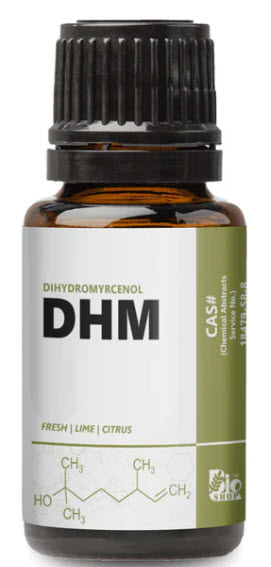Dihydromyrcenol (DHM): An Aroma Chemical in Perfumery
Dihydromyrcenol, commonly abbreviated as DHM, is a synthetic aroma chemical widely used in modern perfumery. It is valued for its fresh, clean, and citrusy scent, which makes it a popular choice for creating bright, uplifting, and modern fragrances. Below is a detailed explanation of DHM, including its properties, uses, and significance in perfumery.

1. Chemical Structure and Properties
- Chemical Name: Dihydromyrcenol
- IUPAC Name: 2,6-Dimethyl-7-octen-2-ol
- Molecular Formula: C₁₀H₂₀O
- Molecular Weight: 156.27 g/mol
- Appearance: A colorless to pale yellow liquid.
- Odor: Fresh, citrusy, floral, and slightly woody with a clean, soapy undertone.
- Solubility: Insoluble in water but soluble in alcohol and oils, making it suitable for use in perfumes and cosmetic formulations.
- Boiling Point: Approximately 213°C (415°F).
- Stability: Stable under normal conditions but can degrade under strong acids, bases, or UV light.
2. Natural Occurrence
Dihydromyrcenol is a synthetic compound and does not occur naturally in significant quantities. It is derived from myrcene, a terpene found in essential oils such as:
- Bay Leaf
- Hops
- Lemongrass
- Pine
However, the DHM used in perfumery is synthesized in laboratories to ensure consistency, purity, and cost-effectiveness.
3. Role in Perfumery
Dihydromyrcenol is a versatile fragrance ingredient with several key roles:
- Top Note: It is often used as a top note in perfumes, providing an immediate burst of freshness and brightness.
- Blending Agent: It harmonizes well with other citrus, floral, and woody notes, creating a balanced and modern scent profile.
- Freshness Enhancer: It adds a clean, soapy, and uplifting quality to fragrances, making it ideal for fresh and aquatic compositions.
- Masking Agent: It can help mask unpleasant odors in functional products like detergents and cleaning agents.
4. Fragrance Profile
Dihydromyrcenol contributes the following olfactory characteristics to a perfume:
- Citrusy: Adds a bright, lemony, and slightly lime-like freshness.
- Floral: Enhances floral accords, particularly in modern and aquatic fragrances.
- Clean: Provides a soapy, laundry-like cleanness.
- Woody: Imparts a subtle woody undertone, adding depth to the fragrance.
- Uplifting: Creates a light, airy, and invigorating effect.
5. Common Uses in Perfumes
Dihydromyrcenol is a staple in many fragrance families, including:
- Fresh Fragrances: It is a key component in fresh and citrusy perfumes, particularly those featuring lemon, bergamot, and lime.
- Aquatic Fragrances: Its clean and soapy qualities make it ideal for aquatic and marine compositions.
- Floral Fragrances: It enhances modern floral accords, particularly in white floral and green floral perfumes.
- Functional Fragrances: It is widely used in detergents, fabric softeners, and household cleaners due to its fresh and clean scent.
6. Safety and Regulation
Dihydromyrcenol is generally considered safe for use in cosmetics and fragrances when used within recommended concentrations. Key points include:
- IFRA Compliance: The International Fragrance Association (IFRA) sets guidelines for the maximum allowable concentration of dihydromyrcenol in different product types to ensure safety.
- Allergen Potential: It is not classified as a significant allergen, but it is always recommended to conduct patch tests to ensure it does not cause adverse reactions in sensitive individuals.
7. Advantages in Perfumery
- Versatility: It blends well with a wide range of fragrance materials, including citrus, florals, and woods.
- Freshness: Its bright and clean scent profile makes it ideal for modern and uplifting fragrances.
- Cost-Effectiveness: As a synthetic ingredient, it is more affordable than natural alternatives with similar scent profiles.
8. Limitations
- Overuse: Due to its popularity, it can be overused in some fragrances, leading to a generic or “synthetic” smell.
- Regulatory Restrictions: Compliance with IFRA and EU regulations may restrict its use in certain formulations.
9. Example Perfumes Featuring Dihydromyrcenol
Dihydromyrcenol is found in numerous iconic fragrances, including:
- Davidoff Cool Water: Enhances the fresh and aquatic notes.
- Calvin Klein Escape: Complements the floral and fruity accords.
- Issey Miyake L’Eau d’Issey: Adds brightness and cleanness to the aquatic floral composition.
10. Conclusion
Dihydromyrcenol (DHM) is a fundamental aroma chemical in modern perfumery, prized for its fresh, citrusy, and clean characteristics. Its ability to act as a top note, blending agent, and freshness enhancer makes it indispensable in creating bright, uplifting, and modern fragrances. While it is generally safe, its potential for overuse necessitates careful formulation and adherence to regulatory guidelines. Its versatility and affordability ensure its continued prominence in the fragrance industry.